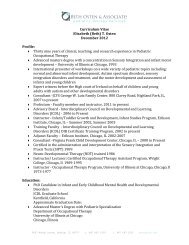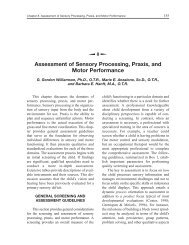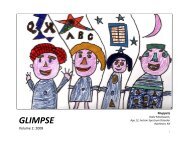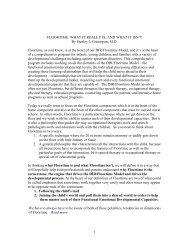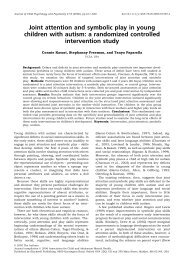Minding the Baby: A Reflective Parenting Program - Interdisciplinary ...
Minding the Baby: A Reflective Parenting Program - Interdisciplinary ...
Minding the Baby: A Reflective Parenting Program - Interdisciplinary ...
You also want an ePaper? Increase the reach of your titles
YUMPU automatically turns print PDFs into web optimized ePapers that Google loves.
week came <strong>the</strong> small but significant indications that <strong>the</strong> capacity to identify and reflect upon her internal states<br />
had begun to take root. She could not talk about <strong>the</strong> baby, but she could talk about her childhood experiences;<br />
slowly she found words for <strong>the</strong> terror that was associated with <strong>the</strong>se remembrances, and for her own needs for<br />
comfort and support. These were feelings she had all but deleted from her awareness. First came <strong>the</strong> memories,<br />
and <strong>the</strong> feelings, and <strong>the</strong>n came <strong>the</strong> effort to make meaning. She began to create a narrative, a story line that she<br />
could reflect upon, making meaning of <strong>the</strong> present in light of <strong>the</strong> past. The social worker worried that delving<br />
into such memories would be too painful and overwhelming for Mia, and she watched vigilantly for signs of<br />
traumatic stress. She did not push, but instead remained gently present, watching for Mia's glazing over, <strong>the</strong><br />
sign that she had remembered and described all that she could.<br />
At four months of age, Noni was an attractive and communicative baby, who in many ways managed to ignite<br />
Mia's maternal capacities. On occasion, she could elicit maternal traits in Mia such as affection, playfulness, and<br />
pride. Mia's competence and efforts to attend to <strong>the</strong> routine care, if not <strong>the</strong> emotional care, of <strong>the</strong> infant, were<br />
highlighted and validated. “There's no one else that can comfort her like you. Look how she's gazing right at<br />
you as if to say ‘thanks.’” This kind of comment, repeated multiple times over multiple home visits, fed Mia on<br />
many levels, and acknowledged her importance to <strong>the</strong> baby in ways that she herself could not yet recognize.<br />
Despite being unable to recognize her baby's experience, she was, however, able to express complex feelings<br />
about her: “I don't regret <strong>the</strong> baby, but I wish I didn't have her so young.”<br />
At <strong>the</strong> same time that Mia could care for Noni competently and sometimes lovingly, she could also be quite<br />
aggressive and harsh with her. She had at this point no capacity to recognize or tolerate fear or distress in her<br />
baby (having not yet been able to articulate her own fears and need for comfort), especially fear and distress that<br />
she herself generated. Mia's game of choice was to startle her infant, which she would do in a variety of ways.<br />
She would loom into <strong>the</strong> baby's face quickly, smiling in a threatening way as she approached menacingly, or<br />
she would shove a shrill squeaking toy intrusively in her face. Mia delighted in this game, oblivious to Noni's<br />
startled grimace and frozen expression. Noni would attempt a false, scared smile, as if she needed to placate<br />
Mia and keep her at bay. Repeatedly, Mia raised <strong>the</strong> threshold for tension, but did little to soo<strong>the</strong> <strong>the</strong> frightened<br />
baby, re-enacting her own helplessness as a child. This scary experience was repeated again and again, with <strong>the</strong><br />
o<strong>the</strong>r adults' finding similar pleasure in startling and overwhelming Noni.<br />
Equally disturbing was <strong>the</strong> fact that not only did Mia fail to recognize Noni's fear, but that she viewed Noni's<br />
response as false and manipulative. Whenever Noni would become distressed—not only with <strong>the</strong> startle game,<br />
but at times when she took a tumble or hurt herself—Mia would respond indignantly with some version of <strong>the</strong><br />
following: “Faker! Big fake-crier! You don't fool anyone.” Thus, Noni's self-experience was both disavowed<br />
and distorted within <strong>the</strong> context of her mo<strong>the</strong>r's response; it is <strong>the</strong>se kinds of early relational experiences that<br />
Fonagy and his colleagues (2002) so richly describe as fundamental to a child's developing an abiding feeling of<br />
alienation and emptiness. Even in <strong>the</strong>se early months we could see Noni dissociated and frightened in<br />
interaction with her mo<strong>the</strong>r.<br />
The next task was clearly to help Mia recognize her baby's fear and distress, feelings that were at this juncture<br />
too threatening for Mia to see, even in her own history. We began by trying to elicit curiosity about <strong>the</strong> baby's<br />
intent, “Why is she fake-crying? What could she want by calling out to you?” Focusing on <strong>the</strong> baby's intentions<br />
helped Mia slowly attend to <strong>the</strong> cues or events that led up to <strong>the</strong> baby's distress. It also served as a chance to<br />
allow Mia to reflect upon her own experience of <strong>the</strong> crying. “How does it feel when you think Noni is trying to<br />
trick you into paying attention to her?” Her responses opened up a discussion about <strong>the</strong> “street's” code of<br />
emanating fearlessness, denying needs, and feeling excited by fear. After revisiting <strong>the</strong>se <strong>the</strong>mes many times



